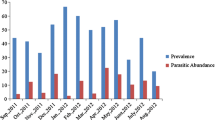Abstract
In June 2010, in small flock of turkeys (n = 45) that co-bred with domestic hens (n = 30) and pigeons (n = 35), a disease occurred with the clinical signs of pendulum crop, in appetence and loppy wings. Disease had morbidity (10.3 %) and mortality (6/6 %). Three carcasses and two ill turkeys were referred to the Veterinary clinic in Zabol region for diagnosis and treatment of disease. At necropsy, the oral cavity/crop small yellowish-white masses were characterized. Necrosis in mucosal of crop to gizzard increased and in the crop smelly yellowish green secretions were characterized. According to clinical and necropsy, strong suspicion to trichomoniasis was very high so for perfect diagnosing samples were taken from dead and live turkeys. Samples were taken from oral cavity, esophagus and crop mucous membranes indicated Trichomonas spp infection. 9 out of 45 pieces of turkey (20 %), 23 out of 35 pieces pigeons (65.7 %) were infected but the domestic hens were not contaminated. The result of this study indicates that tricomoniasis can be an important disease of turkeys in Iran co-bred with pigeons and domestic hens.



Similar content being viewed by others
References
Abraham R, Honigberg BM (1964) Structure of Trichomonas gallinae (Rivolta). J parasitol 50:608–619
Anderson NL, Grahn RA, Van Hoosear K, BonDurant RH (2009) Studies of trichomonad protozoa in free ranging songbirds: prevalence of Trichomonas gallinae in house finches Carpodacus mexicanus and corvids and a novel trichomonad in mockingbirds Mimus polyglottos. Vet Parasitol 161:178–186
Begum N, Mamun MAA, Rahman SA, Bari ASM (2008) Epidemiology and pathology of Trichomonas gallinae in the common pigeon (Columba livia). J Bangladesh Agric Univ 6:301–306
Borji H, Razmi GH, Movassaghi AH, Moghaddas E, Azad M (2011) Prevalence and pathological lesion of Trichomonas gallinae in pigeons of Iran. J Parasit Dis 35:186–189
Cover AJ, Harmon WM, Thomas MW (1994) A new method for the diagnosis of Trichomonas gallinae infection by culture. J Wildl Dis 30:457–459
De Carli GA, Pansera MCG, Guerrero J (1979) Trichomonas gallinae (Rivolta, 1878) Stabler, 1938, no trato digestivo superior de pombos domesticos, Columba livia, no Rio Grande do Sul-Primeiro Registro. Acta Biol Leopoldensia 1:85–95
Erwin KG, Kloss C, Lyles J, Felderhoff J, Fedynich AM, Henke SE, Roberson JA (2000) Survival of Trichomonas gallinae in white-winged dove carcasses. J Wildl Dis 36:551–554
Gerhold RW, Tate CM, Gibbs SE, Mead DG, Allison AB, Fischer JR (2007) Necropsy findings and arbovirus surveillance in mourning doves from the southeastern United States. J Wildl Dis 43:129–135
Khammar GA, Heydari A, Shahmoradi L (2011) Analysis of the status of traditional knowledge and technology in energy improvement: the case of Sistan Region, Iran. J Geogr Reg Plan 4:586–592
Krone O, Altenkamp R, Kenntner N (2005) Prevalence of Trichomonas gallinae in northern goshawks from the Berlin area of northeastern Germany. J Wildl Dis 41:304–309
Mayahi M, Nabavi L, Zebardast M (2007) Prevalence of Trichomonas in pigeons and domestic hens in Ahvaz. Iran Vet J 3:25–30
McKeon T, Dunsmore J, Raidal SR (1997) Trichomonas gallinae in budgerigars and columbid birds in Perth, Western Australia. Aust Vet J 75:652–655
Narcisi EM, Sevoian M, Honigberg BM (1991) Pathologic changes in pigeons infected with a virulent Trichomonas gallinae strain (Eiberg). Avian Dis 35:55–61
Ponce Gordo F, Herrera S, Castro AT, Garcia Duran B, Martinez Diaz RA (2002) Parasites from farmed ostriches Struthio camelus and rheas Rhea americana in Europe. Vet Parasitol 107:137–160
Saif YM, Barnes HJ, Glisson JR, Fadly AM, McDougald LR, Swayne DE (2003) Diseases of poultry, 11th edn. Iowa State Press, Iowa, pp 1103–1113
Samour JH, Naldo JL (2003) Diagnosis and therapeutic management of trichomoniasis in falcons in Saudi Arabia. J Avian Med Surg 17:136–143
Soulsby EJL (1982) Helminths, arthropods and protozoa of domesticated animals, 7th edn. Bailliere Tindall, London
Tasca T, De Carli GA (1999) Prevalence of Trichomonas gallinae from the upper digestive tract of the common pigeon, Columba livia in the Southern Brazilian State, Rio Grande do Sul. Parasitol Dis 23:42–43
Toro H, Saucedo C, Borie C, Gough RE, Alcaino H (1999) Health status of free-living pigeons in the city of Santiago. Avian pathol 28:619–623
Villanua D, HoFle U, PeRez-RodriGuez L, Gortazar C (2006) Trichomonas gallinae in wintering common wood pigeons Columba palumbus in Spain. Ibis 148:641–648
Author information
Authors and Affiliations
Corresponding author
Rights and permissions
About this article
Cite this article
Mirzaei, M., Ghashghaei, O. & Khedri, J. First report of an outbreak trichomoniasis in turkey in Sistan, Iran. J Parasit Dis 40, 61–64 (2016). https://doi.org/10.1007/s12639-014-0445-3
Received:
Accepted:
Published:
Issue Date:
DOI: https://doi.org/10.1007/s12639-014-0445-3




